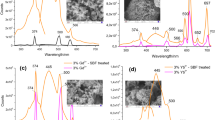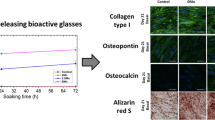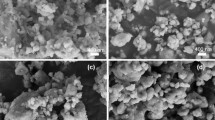Abstract
Luminescent europium-containing bioactive glasses (EuBG) based on the 58 %SiO2–33 %CaO–9 %P2O5 (in mass, %) system were synthesized using sol–gel technique by adding Eu2O3 in silica network. The structural, textural and optical properties, as well as in vitro bioactivity and biocompatibility of the material were characterized using various methods. The results show that all the Eu-containing bioactive glass materials exhibit an amorphous structure, large specific surface area, relatively uniform pore size distribution and high in vitro bioactivity, similar to the conventional sol–gel bioactive glass. More importantly, the addition of Eu2O3 endow the material with a luminescent property even after immersion in aqueous solution and the luminescent intensity increases with the increase of Eu2O3 content. The cytotoxicity assay indicates that pure EuBG extract significantly inhibit the growth of rat marrow mesenchymal stem cells (rMSCs), while 25 % concentration of the extract diluted by culture medium could significantly improve the proliferation of rMSCs in comparison with pure medium. According to the above results, the material presents excellent apatite-forming activity, luminescent property and biocompatibility, demonstrating their potential applications in the fields of bone regeneration and drug delivery system.









Similar content being viewed by others
References
Hench LL, Splinter RJ, Allen WC, Greenlee TK (1971) Bonding mechanisms at the interface of ceramic prosthetic materials. J Biomed Mater Res 5(6):117–141
Ogino M, Ohuchi F, Hench L (1980) Compositional dependence of the formation of calcium phosphate films on bioglass. J Biomed Mater Res 14(1):55–64
Hench L (1991) Bioceramics: from concept to clinic. J Am Ceram Soc 74(7):1487–1510
Greenspan D, Hench L (1976) Chemical and mechanical behavior of bioglass-coated alumina. J Biomed Mater Res 10(4):503–509
Wilson J, Pigott G, Schoen F, Hench L (1981) Toxicology and biocompatibility of bioglasses. J Biomed Mater Res 15(6):805–817
Xynos I, Edgar A, Buttery L, Hench L, Polak J (2000) Ionic products of bioactive glass dissolution increase proliferation of human osteoblasts and induce insulin-like growth factor II mRNA expression and protein synthesis. Biochem Biophys Res Commun 276(2):461–465
Xynos ID, Hukkanen MVJ, Batten JJ, Buttery LD, Hench LL, Polak JM (2000) Bioglass® 45S5 stimulates osteoblast turnover and enhances bone formation in vitro: implications and applications for bone tissue engineering. Calcif Tissue Int 67(4):321–329. doi:10.1007/s002230001134
Xynos I, Edgar A, Buttery L, Hench L, Polak J (2001) Gene-expression profiling of human osteoblasts following treatment with the ionic products of Bioglass® 45S5 dissolution. J Biomed Mater Res 55(2):151–157
Hench L, West J (1990) The sol–gel process. Chem Rev 90(1):33–72
Pereira M, Clark A, Hench L (1994) Calcium phosphate formation on sol–gel-derived bioactive glasses in vitro. J Biomed Mater Res 28(6):693–698
Gough J, Jones J, Hench L (2004) Nodule formation and mineralisation of human primary osteoblasts cultured on a porous bioactive glass scaffold. Biomaterials 25(11):2039–2046
Vallet-Regí M, Rámila A (2000) New bioactive glass and changes in porosity during the growth of a carbonate hydroxyapatite layer on glass surfaces. Chem Mater 12(4):961–965
Balas F, Arcos D, Pérez-Pariente J, Vallet-Regí M (2001) Textural properties of SiO2–CaO–P2O5 glasses prepared by the sol–gel method. J Mater Res 16(5):1345–1348
Salinas A, Martin A, Vallet-Regí M (2002) Bioactivity of three CaO–P2O5–SiO2 sol–gel glasses. J Biomed Mater Res 61(4):524–532
Arcos D, Pena J, Vallet-Regi M (2004) Textural evolution of a sol–gel glass surface in SBF. Key Eng Mater 254–256:27–30
Ferreira JMF, Balamurugan A, Balossier G, Kannan S, Michel J, Rebelo AHS (2007) Development and in vitro characterization of sol–gel derived CaO–P2O5–SiO2–ZnO bioglass. Acta Biomater 3(2):255–262
El-Kheshen AA, Khaliafa FA, Saad EA, Elwan RL (2008) Effect of Al2O3 addition on bioactivity, thermal and mechanical properties of some bioactive glasses. Ceram Int 34(7):1667–1673
Ferreira JMF, Balamurugan A, Balossier G, Laurent-Maquin D, Pina S, Rebelo AHS, Faure J (2008) An in vitro biological and anti-bacterial study on a sol–gel derived silver-incorporated bioglass system. Dent Mater 24(10):1343–1351
Saboori A, Rabiee M, Mutarzadeh F, Sheikhi M, Tahriri M, Karimi M (2009) Synthesis, characterization and in vitro bioactivity of sol–gel-derived SiO2–CaO–P2O5–MgO bioglass. Mater Sci Eng C 29(1):335–340
Zhu Y, Li X, Yang J, Wang S, Gao H, Hanagata N (2011) Composition-structure-property relationships of the CaO-MxOy–SiO2–P2O5 (M = Zr, Mg, Sr) mesoporous bioactive glass (MBG) scaffolds. J Mater Chem 21(25):9208–9218
Ma J, Chen C, Wang D, Meng X, Shi J (2010) In vitro degradability and bioactivity of mesoporous CaO–MgO–P2O5–SiO2 glass synthesized by sol–gel method. J Sol–Gel Sci Techn 54(1):69–76. doi:10.1007/s10971-010-2159-z
Han PP, Wu CT, Chang J, Xiao Y (2012) The cementogenic differentiation of periodontal ligament cells via the activation of Wnt/β-catenin signalling pathway by Li+ ions released from bioactive scaffolds. Biomaterials 33(27):6370–6379. doi:10.1016/j.biomaterials.2012.05.061
Piaoping Y, Zewei Q, Chunxia L, Xiaojiao K, Hongzhou L, Jun L (2008) Bioactive, luminescent and mesoporous europium-doped hydroxyapatite as a drug carrier. Biomaterials 29(32):4341–4347
Piaoping Y, Zewei Q, Zhiyao H, Chunxia L, Xiaojiao K, Ziyong C, Jun L (2009) A magnetic, luminescent and mesoporous core-shell structured composite material as drug carrier. Biomaterials 30(27):4786–4795. doi:10.1016/j.biomaterials.2009.05.038
Ocaña M, Cantelar E, Cussó F (2011) A facile single-step procedure for the synthesis of luminescent Ln3+:YVO4 (Ln = Eu or Er + Yb)-silica nanocomposites. Mater Chem Phys 125(1–2):224–230. doi:10.1016/j.matchemphys.2010.09.011
Shruti S, Salinas AJ, Lusvardi G, Malavasi G, Menabue L, Vallet-Regi M (2013) Mesoporous bioactive scaffolds prepared with cerium-, gallium- and zinc-containing glasses. Acta Biomater 9(1):4836–4844. doi:10.1016/j.actbio.2012.09.024
Fan Y, Yang P, Huang S, Jiang J, Lian H, Lin J (2009) Luminescent and mesoporous europium-doped bioactive glasses (MBG) as a drug carrier. J Am Chem Soc 131(10):3462–3463
Li R, Clark AE, Hench LL (1991) An investigation of bioactive glass powders by sol–gel processing. J Appl Biomater 2(4):231–239. doi:10.1002/jab.770020403
Kokubo T, Takadama H (2006) How useful is SBF in predicting in vivo bone bioactivity? Biomaterials 27(15):2907–2915
Roman J, Padilla S, Vallet-Regi M (2003) Sol–gel glasses as precursors of bioactive glass ceramics. Chem Mater 15(3):798–806
Saravanapavan P, Jones JR, Pryce RS, Hench LL (2003) Bioactivity of gel-glass powders in the CaO–SiO2 system: a comparison with ternary (CaO–P2O5–SiO2) and quaternary glasses (SiO2–CaO–P2O5–Na2O). J Biomed Mater Res Part A 66(1):110–119. doi:10.1002/jbm.a.10532
Sing KSW, Everett DH, Haul R, Moscou L, Pierotti RA, Rouquerol J, Siemieniewska T (1982) Reporting physisorption data for gas/solid systems with special reference to the determination of surface area and porosity. Pure Appl Chem 54(11):2201–2218
Lei B, Chen X, Wang Y, Zhao N, Du C, Zhang L (2009) Acetic acid derived mesoporous bioactive glasses with an enhanced in vitro bioactivity. J Non-Cryst Solids 355(52–54):2583–2587
Binnemans K, Van Deun R, Görller-Walrand C, Adam JL (1998) Spectroscopic properties of trivalent lanthanide ions in fluorophosphate glasses. J Non-Cryst Solids 238(1–2):11–29
Acknowledgments
This work was supported by the Key Project of the National Natural Science Foundation of China (Grant No. 50830101), National Natural Science Foundation of China (Grant Nos. 51072055, 51172073, 51202069), the National 973 project of China (2011CB606204), Research Fund for the Doctoral Program of Higher Education of China (20110172110002), the Fundamental Research Funds for the Central University (2012ZP0001), the Fundamental Research Funds for the Central Universities (2013ZM0043) and the Zhejiang Provincial Natural Science Foundation of China (Z2080985).
Author information
Authors and Affiliations
Corresponding author
Rights and permissions
About this article
Cite this article
Miao, G., Chen, X., Mao, C. et al. Synthesis and characterization of europium-containing luminescent bioactive glasses and evaluation of in vitro bioactivity and cytotoxicity. J Sol-Gel Sci Technol 69, 250–259 (2014). https://doi.org/10.1007/s10971-013-3209-0
Received:
Accepted:
Published:
Issue Date:
DOI: https://doi.org/10.1007/s10971-013-3209-0




